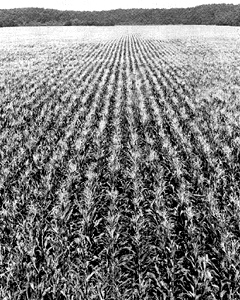
Corn
Corn was the chief agricultural product almost from the beginning of human settlement in Tennessee. Referred to as “Indian corn” throughout the 1800s, the cereal was widely cultivated by the Cherokees and formed a basic element of their diet. Most southern tribes practiced some form of the summer “green corn” festival in celebration of the life-giving grain.
The fact that corn could, with reasonable success, be grown in newly cleared ground made it the staple crop on most pioneer farms. Planted as soon as land was cleared (or even before, in hills between the stumps), corn was cultivated through May and June, “laid by” in July and August, then picked by hand in early autumn. It provided the basic sustenance for pioneer farmers. Corn whiskey was the distinctive drink of the Scots-Irish pioneer–a home distilled palliative easy to make and far cheaper than imported rum or wine. The adoption of cornmeal and pone was a benchmark of Americanization, that is, of the settlers’ moving away from the European and coastal preference for wheat flour and bread to local corn-based products.
Corn was admirably suited to the southern growing season; it produced a large amount of starch and glucose for fattening livestock; it was susceptible to few diseases or insect pests; and it yielded a larger food product than any other cereal. The amount of corn grown was closely tied to the production of hogs, for which it was the principal feed. Corn and hogs complemented one another perfectly and offered a type of farming well suited to the state’s many small landholders. As the basic ingredient in fattening animals for meat and in its other forms–meal, grits, hominy, whiskey–corn constituted the staple of most Tennesseans’ diets.
By 1840 Tennessee was the leading corn-producing state in the Union, with 12 percent of the nation’s total. Ten years later, the state grew enough corn to feed its three million hogs, the most in the nation. It made an ideal commercial crop since it could be readily transformed into marketable commodities like cured pork, whiskey, and cornmeal. Such products were easily stored and shipped by riverboat to the cotton-growing areas of the Deep South. As plantations concentrated on cotton before the Civil War, the granaries of border states like Tennessee grew correspondingly. Tennessee produced twice as much “Indian corn” between 1850 and 1860 as all other grains combined, and its prolific corn-hog agriculture served as a breadbasket for the Cotton South.
Corn continued to play a prominent role in post-Civil War agriculture, although prices did not recover to their pre-war level for several decades. While corn was grown universally before the war as a means of self-sufficiency, afterwards production began to follow market prices. Middle Tennessee counties such as Maury, Bedford, Wilson, Williamson, and Rutherford were the powerhouse corn producers for most of the nineteenth century. The extent of production was highest in 1900 with 3.37 million acres planted yielding an average of twenty-eight bushels (or about five “barrels,” as corn was then measured) per acre. Traditionally, Tennesseans preferred single-ear, white varieties of corn such as White Dent and Tennessee Red Cob, although multi-eared varieties such as Neal’s Paymaster were gaining acceptance by the twentieth century.
The value and amount of corn harvested peaked in 1920, after which Tennessee agriculture in general began a slow decline. The corn harvest lost half of its value from 1920 to 1925. The introduction of modern hybrids, tractors and mechanical pickers, chemical insecticides, and fertilizers greatly increased the yield (and cost) of corn farming, even as acreage and the number of farmers declined. Extensive dam construction in Tennessee also reduced accessibility to river bottoms–land that had been devoted almost exclusively to corn.
The productivity of corn farming quadrupled following World War II, with higher yields being produced on considerably less land. Cultivation also migrated westward in the state. By 1954 nine of the top ten corn-producing counties were in West Tennessee, with Weakley, Gibson, and Obion leading the way. Also during the 1950s cotton and tobacco finally surpassed corn in terms of cash value. Once vital to the subsistence and commercial life of rural Tennesseans, corn continues to play a significant, though much diminished, role in the state’s farm economy.



